The Acer Aspire S7-393 Review: Broadwell Comes To Acer's Ultrabook
by Brett Howse on October 5, 2015 8:00 AM ESTDisplay
Acer does offer the Aspire S7 with a 2560x1440 display, but the model shipped to me has the base 1920x1080 IPS panel. This touch panel has a full RGB stripe and being IPS offers great off-angle viewing. The move to 2560x1440 would give slightly crisper text but at the cost of battery life, so it is a choice to not be taken lightly.
The panel itself is an AUO model and right away one of the first things I noticed was that there is quite a bit more backlight bleed than there should be on a notebook at this price range. There is visible leakage on the sides which is not too distracting, but also some uneven blacks. It’s not a huge issue though and is really only noticeable when the display is completely black but the backlight is on a bright setting.
To measure the display characteristics, we use SpectraCal’s CalMAN 5 suite with a custom workflow. Contrast and brightness levels are measures with an X-Rite i1DisplayPro colorimeter, and color accuracy is checked with an X-Rite i1Pro spectrophotometer.
Brightness and Contrast

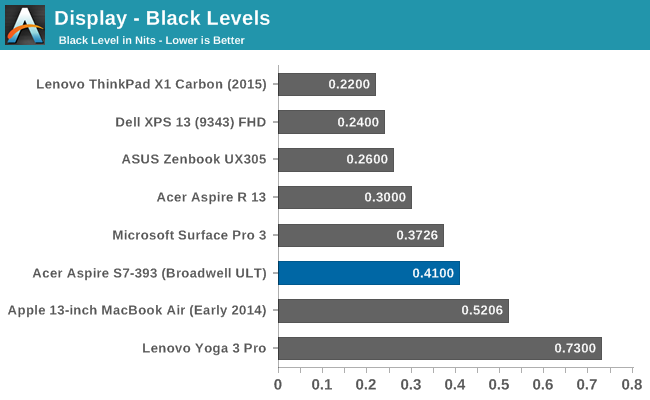
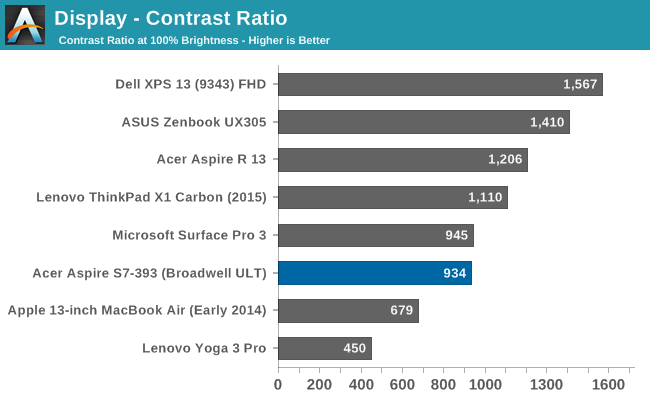
The Acer S7 gets to 391 nits at 100% brightness which is generally plenty bright for more notebook tasks. Decent black levels lead to a static contrast of 934:1. It is not quite as good as the Sharp IGZO panels but a reasonable result.
Grayscale


As you can see in the results, the grayscale is overall 4.16 which is not a terrible result, but the greens really creep up as the display gets closer to 100% white causing noticeable errors as the white value goes up. Color temperature is higher than it should be at 7077 and gamma is also a bit high.
Saturation
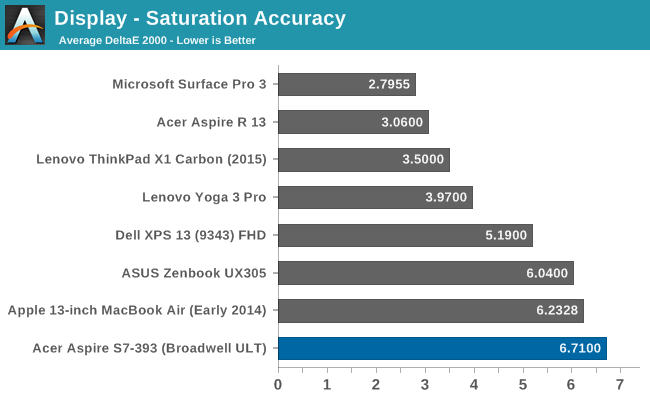
Saturation is where the Acer’s display falls on its face. An overall value of 6.72 is not the worst we have ever seen (by a long shot) but on a $1400 Ultrabook there are some major issues when the display can’t cover the sRGB color space. 100% blue is registering as only 60% blue, which combined with the compressed reds cause the magenta to also be very compressed. The Acer S7 only actually covers 72% of the sRGB gamut which is a very poor performance.
GMB
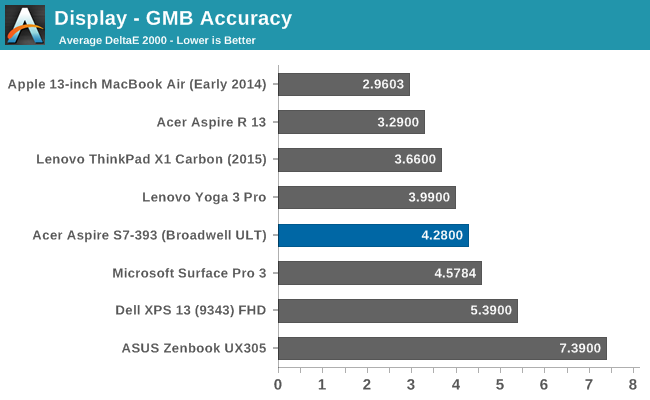
The Gretag Macbeth colorchecker is a more comprehensive test. It comes in at not a terrible result at 4.29 but you can visibly see how much of the blue and magenta gamut is just missing from the result. Good scores on the green, yellow, and decent grayscale help pull this score back to a reasonable result, but in the end we are looking for a dE of less than three, which the S7 does not meet in any of these tests.
Color Comparator
Since discussing color inaccuracies can be difficult to comprehend with just numbers, the above images are a relative comparison of what color is called for (on the bottom) and the color that is reproduced by this display (on the top) with a focus on this being a relative comparison. Any inaccuracies in your own monitor will shift the results for both values. You can really see how the blue values are just not anywhere near as blue as they should be.
Calibrated
Since this is a Windows PC, we can calibrate the display to try and get a better result, however without a 3D Look Up Table the only thing that can really be fixed is gamma and grayscale.
Once calibrated, the grayscale comes out much better, which helps pull the GMB score down further since whites and blacks are part of that test. The saturation sweep shows no difference though.
When a company sells a device for this price, you have to expect and demand better than the display in this notebook. It is really unacceptable to have a display which covers just 72% of sRGB at this price point. The competition has come out with some pretty fantastic displays over the last year or two, so Acer needs to step up their game. It is no longer good enough to just include an IPS panel, at least not at this price. When a $500 Microsoft Surface 3 can come with a fantastically accurate display out of the box, others can do it too.


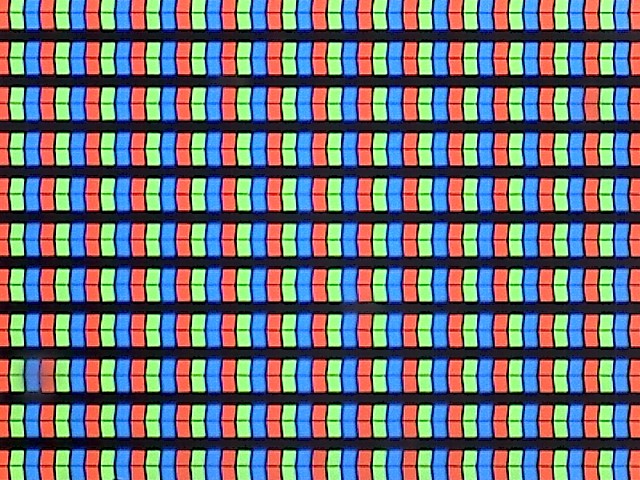
















63 Comments
View All Comments
Samus - Monday, October 5, 2015 - link
I just had a Mushkin PCIe SSD fail entirely because one of the four 128GB SSD's failed.RAID 0 is inherently unreliable because you are increasing the failure points.
Ethos Evoss - Wednesday, October 7, 2015 - link
u such stupid whinner ..who don't thinkEthos Evoss - Tuesday, December 15, 2015 - link
you stupid idiot you can turn raid off if you don't want it and you can carry on using your '' plain" diskWhat a bunch of retards here really
Teknobug - Tuesday, October 6, 2015 - link
lol RAID 0 on the same drive? What theMorawka - Monday, October 5, 2015 - link
i disagree, your getting double the write and double the read speed. Copying large files (movies, ISO's, etc..) will see great benefit.it's a stop gap solution because it does'nt have PCIE SSD
Lolimaster - Monday, October 5, 2015 - link
Copy to what?Copy over an aldready slow wifi/ethernet? Copy to another SSD using USB 3.0? SSD's RAID 0 makes no sense unless you have a workstation/high end PC for heavy video editing.
If you have an SSD Raid 0 you'll only see the speed copying to another SSD Raid 0 o m.2 pci-e SSD.
It's an ultrabook, any kind of speed you get is already bottlenecked by the ultrabook itself (slow external connectivity.
Morawka - Monday, October 5, 2015 - link
copy to the same drive. ie: duplicating filesConverting MKV's, Ripping Blu Ray, 1080P Video Scratch Disk, Adobe Bridge Scratch Disk, 4K Video Scratch Disk and Copying.
There are tons of uses
Kristian Vättö - Tuesday, October 6, 2015 - link
It's an ultrabook, not a mobile workstation. If you plan on doing a lot of video work an ultrabook is a wrong choice in the first place due to the limited processing power.Ethos Evoss - Wednesday, October 7, 2015 - link
u naive stupid kiddo troll.. if u don't know nothing bout computers stop embarrassing yourselfif u have no idea how to simply unRAID two storage drives then go back to school mento
Athlex - Thursday, November 12, 2015 - link
You're partly right. The S7 uses a proprietary double-sided mSATA SSD (Kingston P/N SMS"R"...) which has an identical footprint to a regular mSATA SSD. It's basically two 64/128GB SSDs in a software RAID on the same physical PCB. Fortunately, the mSATA slot can work with traditional mSATA cards if you want to get more capacity or ditch the weird RAID setup.